Rehabilitation of Violent Women Offenders in UK Prisons: A Report
VerifiedAdded on 2020/07/23
|32
|10837
|148
Report
AI Summary
This report delves into the critical issue of rehabilitating violent women offenders within the UK prison system. It begins with an abstract outlining the core focus on reducing re-offending behavior through care and treatment. The report then explores the background of women offenders, highlighting the differences in crimes committed compared to men and the increasing female prison population in the UK. It identifies key factors influencing women offenders' psychology, such as mental health disorders, emotional distress, relationship instability, and drug addiction. A significant portion addresses the prevalence of violence experienced by women in prison. Finally, the report examines various rehabilitation programs like the Policy Triage Scheme, the Women's Programme, and the CARE program. The research uses secondary data collection methods to analyze the positivistic approach to rehabilitation, aiming to comprehend the current state of women's rehabilitation in the UK justice system.
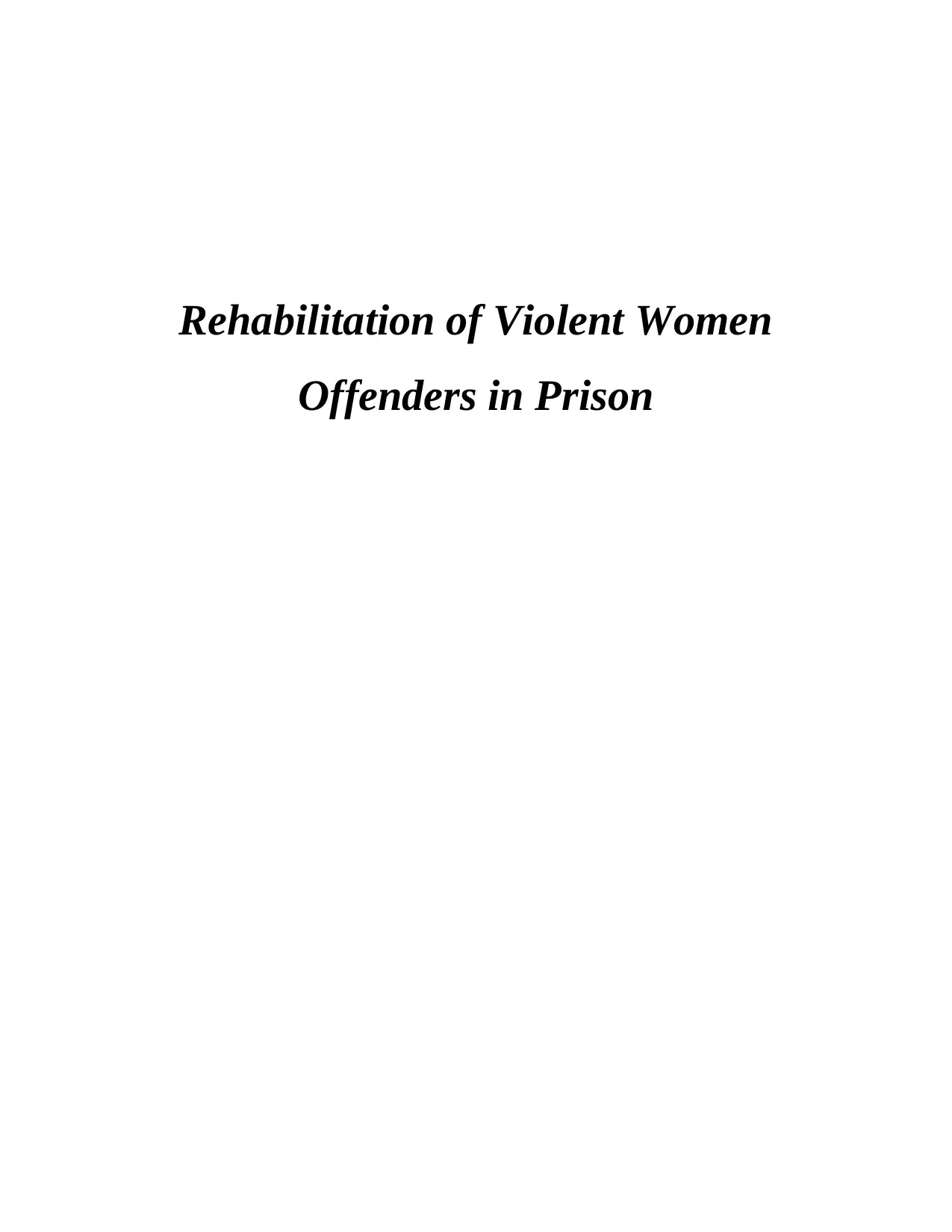
Rehabilitation of Violent Women
Offenders in Prison
Offenders in Prison
Paraphrase This Document
Need a fresh take? Get an instant paraphrase of this document with our AI Paraphraser
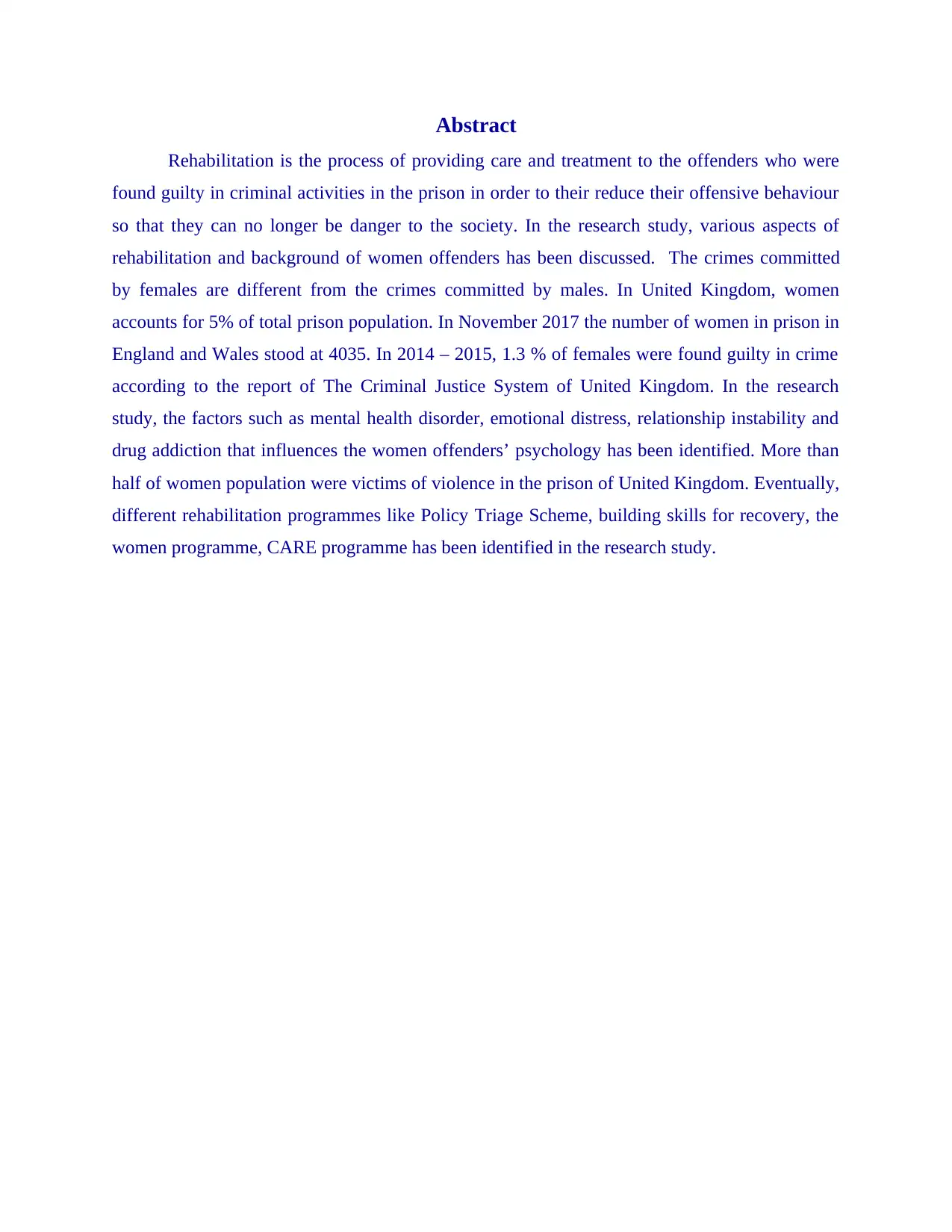
Abstract
Rehabilitation is the process of providing care and treatment to the offenders who were
found guilty in criminal activities in the prison in order to their reduce their offensive behaviour
so that they can no longer be danger to the society. In the research study, various aspects of
rehabilitation and background of women offenders has been discussed. The crimes committed
by females are different from the crimes committed by males. In United Kingdom, women
accounts for 5% of total prison population. In November 2017 the number of women in prison in
England and Wales stood at 4035. In 2014 – 2015, 1.3 % of females were found guilty in crime
according to the report of The Criminal Justice System of United Kingdom. In the research
study, the factors such as mental health disorder, emotional distress, relationship instability and
drug addiction that influences the women offenders’ psychology has been identified. More than
half of women population were victims of violence in the prison of United Kingdom. Eventually,
different rehabilitation programmes like Policy Triage Scheme, building skills for recovery, the
women programme, CARE programme has been identified in the research study.
Rehabilitation is the process of providing care and treatment to the offenders who were
found guilty in criminal activities in the prison in order to their reduce their offensive behaviour
so that they can no longer be danger to the society. In the research study, various aspects of
rehabilitation and background of women offenders has been discussed. The crimes committed
by females are different from the crimes committed by males. In United Kingdom, women
accounts for 5% of total prison population. In November 2017 the number of women in prison in
England and Wales stood at 4035. In 2014 – 2015, 1.3 % of females were found guilty in crime
according to the report of The Criminal Justice System of United Kingdom. In the research
study, the factors such as mental health disorder, emotional distress, relationship instability and
drug addiction that influences the women offenders’ psychology has been identified. More than
half of women population were victims of violence in the prison of United Kingdom. Eventually,
different rehabilitation programmes like Policy Triage Scheme, building skills for recovery, the
women programme, CARE programme has been identified in the research study.
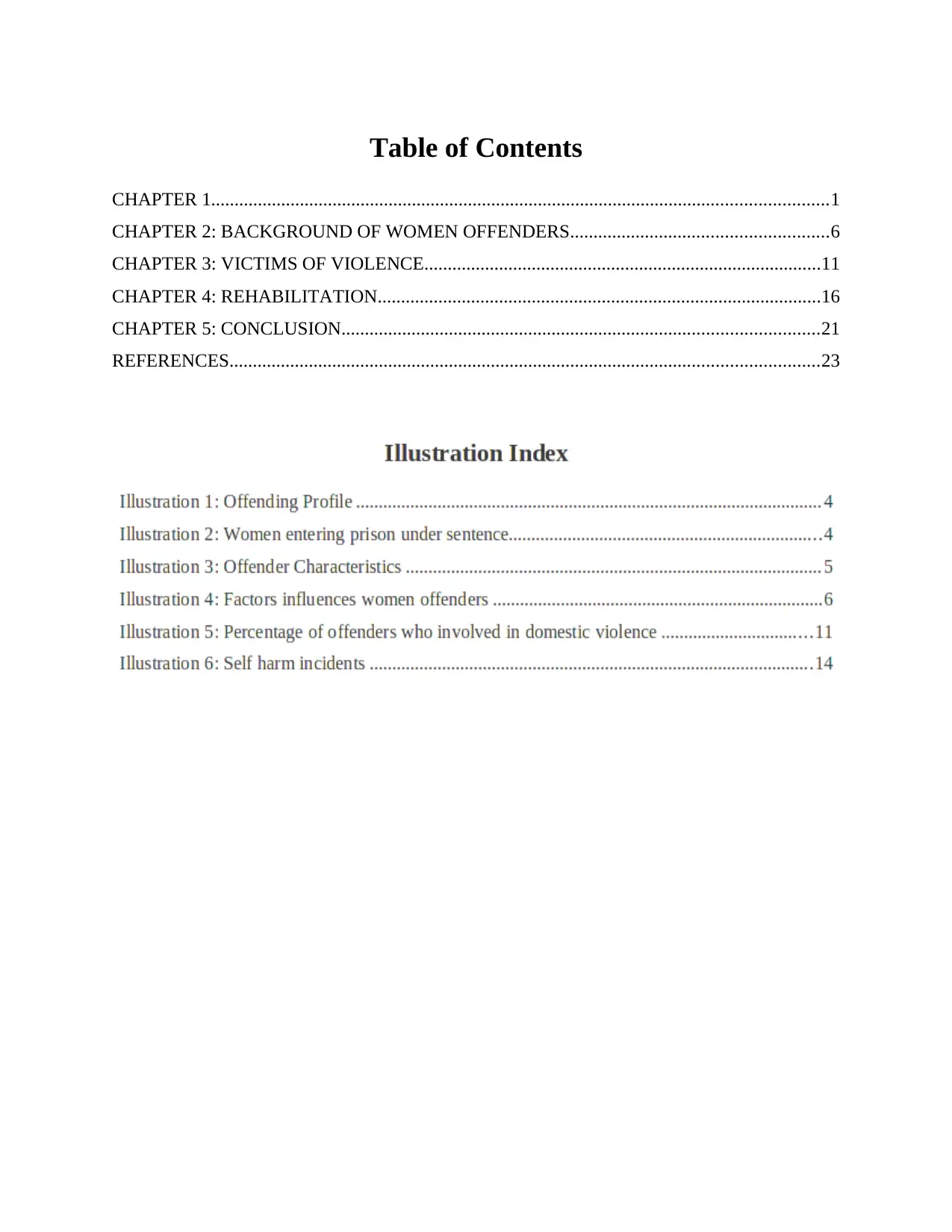
Table of Contents
CHAPTER 1....................................................................................................................................1
CHAPTER 2: BACKGROUND OF WOMEN OFFENDERS.......................................................6
CHAPTER 3: VICTIMS OF VIOLENCE.....................................................................................11
CHAPTER 4: REHABILITATION...............................................................................................16
CHAPTER 5: CONCLUSION......................................................................................................21
REFERENCES..............................................................................................................................23
CHAPTER 1....................................................................................................................................1
CHAPTER 2: BACKGROUND OF WOMEN OFFENDERS.......................................................6
CHAPTER 3: VICTIMS OF VIOLENCE.....................................................................................11
CHAPTER 4: REHABILITATION...............................................................................................16
CHAPTER 5: CONCLUSION......................................................................................................21
REFERENCES..............................................................................................................................23
⊘ This is a preview!⊘
Do you want full access?
Subscribe today to unlock all pages.

Trusted by 1+ million students worldwide
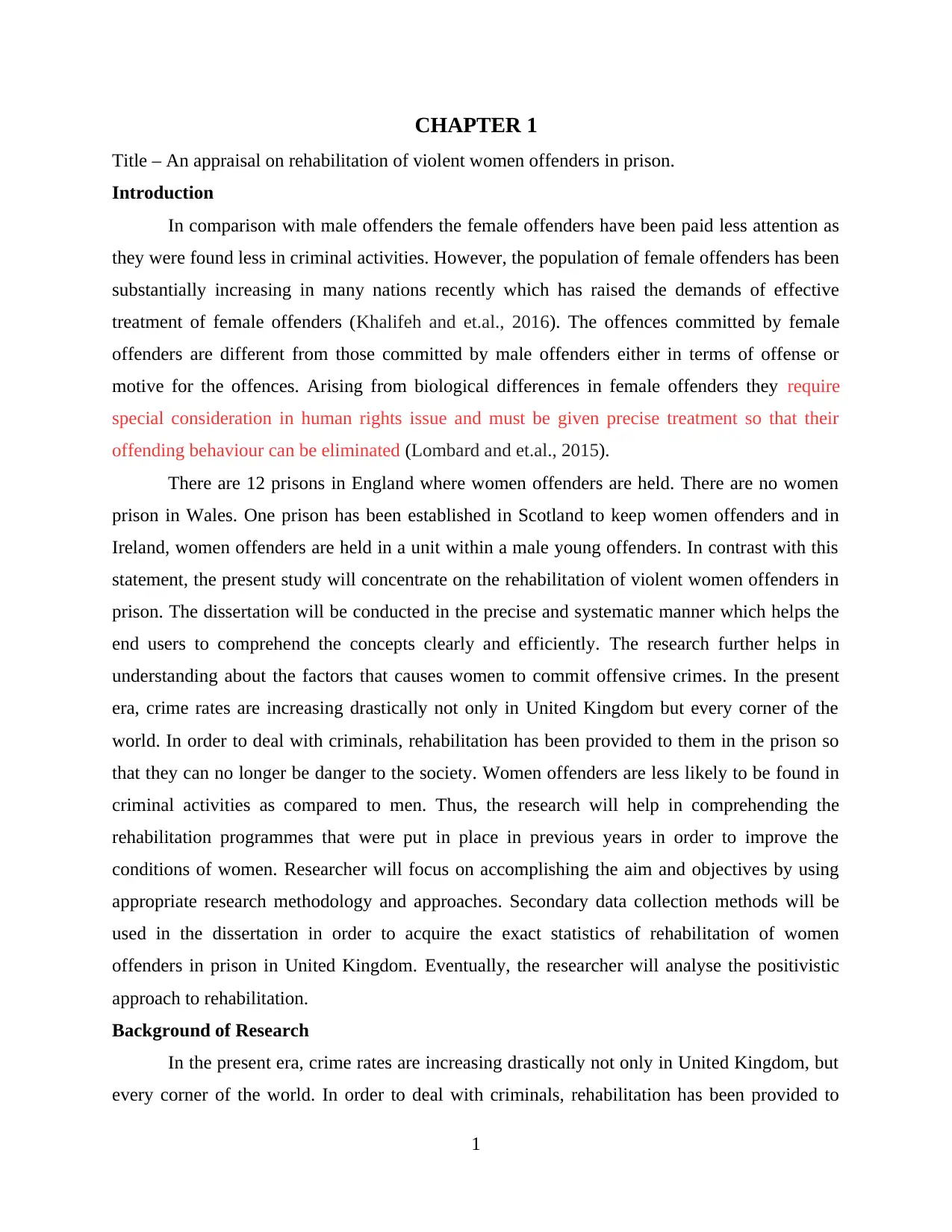
CHAPTER 1
Title – An appraisal on rehabilitation of violent women offenders in prison.
Introduction
In comparison with male offenders the female offenders have been paid less attention as
they were found less in criminal activities. However, the population of female offenders has been
substantially increasing in many nations recently which has raised the demands of effective
treatment of female offenders (Khalifeh and et.al., 2016). The offences committed by female
offenders are different from those committed by male offenders either in terms of offense or
motive for the offences. Arising from biological differences in female offenders they require
special consideration in human rights issue and must be given precise treatment so that their
offending behaviour can be eliminated (Lombard and et.al., 2015).
There are 12 prisons in England where women offenders are held. There are no women
prison in Wales. One prison has been established in Scotland to keep women offenders and in
Ireland, women offenders are held in a unit within a male young offenders. In contrast with this
statement, the present study will concentrate on the rehabilitation of violent women offenders in
prison. The dissertation will be conducted in the precise and systematic manner which helps the
end users to comprehend the concepts clearly and efficiently. The research further helps in
understanding about the factors that causes women to commit offensive crimes. In the present
era, crime rates are increasing drastically not only in United Kingdom but every corner of the
world. In order to deal with criminals, rehabilitation has been provided to them in the prison so
that they can no longer be danger to the society. Women offenders are less likely to be found in
criminal activities as compared to men. Thus, the research will help in comprehending the
rehabilitation programmes that were put in place in previous years in order to improve the
conditions of women. Researcher will focus on accomplishing the aim and objectives by using
appropriate research methodology and approaches. Secondary data collection methods will be
used in the dissertation in order to acquire the exact statistics of rehabilitation of women
offenders in prison in United Kingdom. Eventually, the researcher will analyse the positivistic
approach to rehabilitation.
Background of Research
In the present era, crime rates are increasing drastically not only in United Kingdom, but
every corner of the world. In order to deal with criminals, rehabilitation has been provided to
1
Title – An appraisal on rehabilitation of violent women offenders in prison.
Introduction
In comparison with male offenders the female offenders have been paid less attention as
they were found less in criminal activities. However, the population of female offenders has been
substantially increasing in many nations recently which has raised the demands of effective
treatment of female offenders (Khalifeh and et.al., 2016). The offences committed by female
offenders are different from those committed by male offenders either in terms of offense or
motive for the offences. Arising from biological differences in female offenders they require
special consideration in human rights issue and must be given precise treatment so that their
offending behaviour can be eliminated (Lombard and et.al., 2015).
There are 12 prisons in England where women offenders are held. There are no women
prison in Wales. One prison has been established in Scotland to keep women offenders and in
Ireland, women offenders are held in a unit within a male young offenders. In contrast with this
statement, the present study will concentrate on the rehabilitation of violent women offenders in
prison. The dissertation will be conducted in the precise and systematic manner which helps the
end users to comprehend the concepts clearly and efficiently. The research further helps in
understanding about the factors that causes women to commit offensive crimes. In the present
era, crime rates are increasing drastically not only in United Kingdom but every corner of the
world. In order to deal with criminals, rehabilitation has been provided to them in the prison so
that they can no longer be danger to the society. Women offenders are less likely to be found in
criminal activities as compared to men. Thus, the research will help in comprehending the
rehabilitation programmes that were put in place in previous years in order to improve the
conditions of women. Researcher will focus on accomplishing the aim and objectives by using
appropriate research methodology and approaches. Secondary data collection methods will be
used in the dissertation in order to acquire the exact statistics of rehabilitation of women
offenders in prison in United Kingdom. Eventually, the researcher will analyse the positivistic
approach to rehabilitation.
Background of Research
In the present era, crime rates are increasing drastically not only in United Kingdom, but
every corner of the world. In order to deal with criminals, rehabilitation has been provided to
1
Paraphrase This Document
Need a fresh take? Get an instant paraphrase of this document with our AI Paraphraser
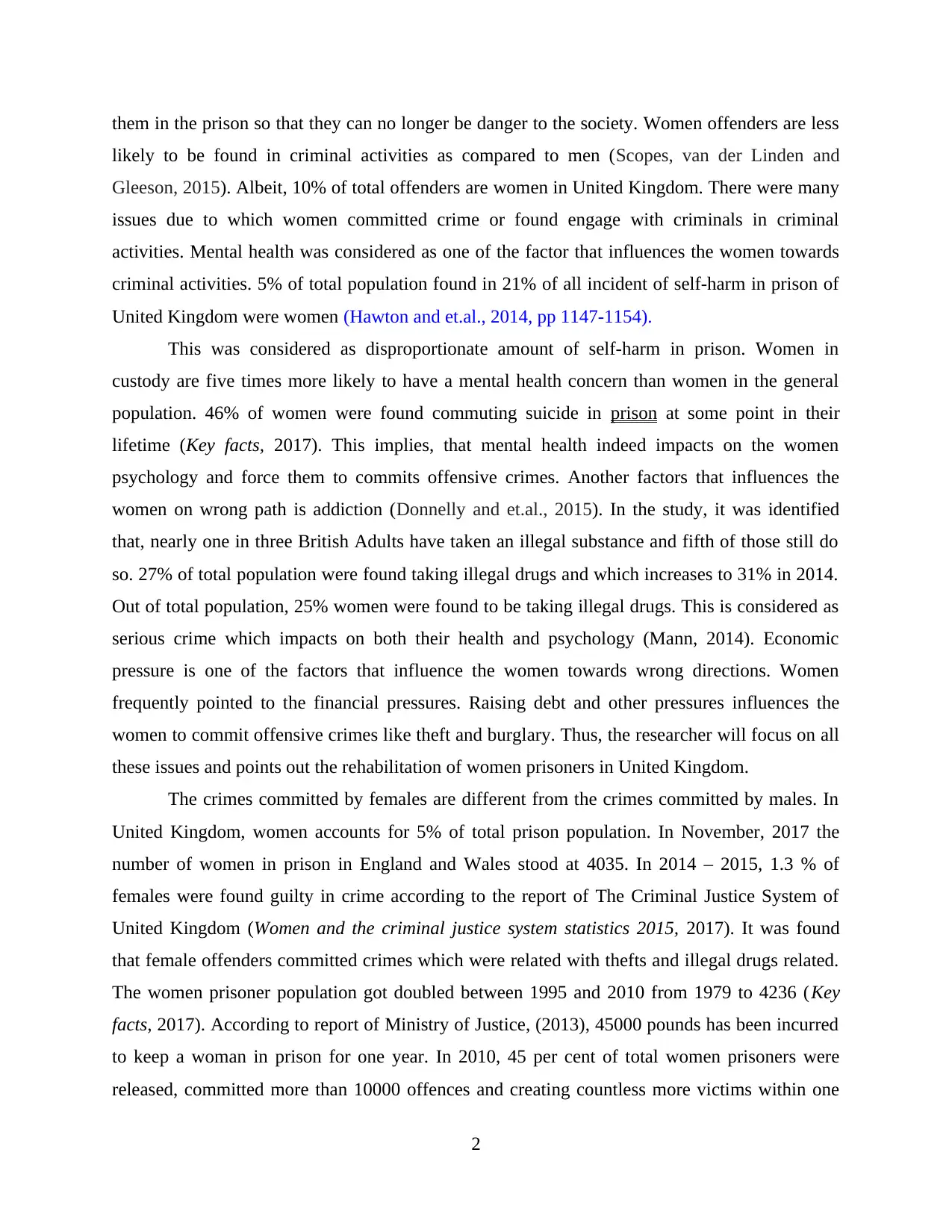
them in the prison so that they can no longer be danger to the society. Women offenders are less
likely to be found in criminal activities as compared to men (Scopes, van der Linden and
Gleeson, 2015). Albeit, 10% of total offenders are women in United Kingdom. There were many
issues due to which women committed crime or found engage with criminals in criminal
activities. Mental health was considered as one of the factor that influences the women towards
criminal activities. 5% of total population found in 21% of all incident of self-harm in prison of
United Kingdom were women (Hawton and et.al., 2014, pp 1147-1154).
This was considered as disproportionate amount of self-harm in prison. Women in
custody are five times more likely to have a mental health concern than women in the general
population. 46% of women were found commuting suicide in prison at some point in their
lifetime (Key facts, 2017). This implies, that mental health indeed impacts on the women
psychology and force them to commits offensive crimes. Another factors that influences the
women on wrong path is addiction (Donnelly and et.al., 2015). In the study, it was identified
that, nearly one in three British Adults have taken an illegal substance and fifth of those still do
so. 27% of total population were found taking illegal drugs and which increases to 31% in 2014.
Out of total population, 25% women were found to be taking illegal drugs. This is considered as
serious crime which impacts on both their health and psychology (Mann, 2014). Economic
pressure is one of the factors that influence the women towards wrong directions. Women
frequently pointed to the financial pressures. Raising debt and other pressures influences the
women to commit offensive crimes like theft and burglary. Thus, the researcher will focus on all
these issues and points out the rehabilitation of women prisoners in United Kingdom.
The crimes committed by females are different from the crimes committed by males. In
United Kingdom, women accounts for 5% of total prison population. In November, 2017 the
number of women in prison in England and Wales stood at 4035. In 2014 – 2015, 1.3 % of
females were found guilty in crime according to the report of The Criminal Justice System of
United Kingdom (Women and the criminal justice system statistics 2015, 2017). It was found
that female offenders committed crimes which were related with thefts and illegal drugs related.
The women prisoner population got doubled between 1995 and 2010 from 1979 to 4236 (Key
facts, 2017). According to report of Ministry of Justice, (2013), 45000 pounds has been incurred
to keep a woman in prison for one year. In 2010, 45 per cent of total women prisoners were
released, committed more than 10000 offences and creating countless more victims within one
2
likely to be found in criminal activities as compared to men (Scopes, van der Linden and
Gleeson, 2015). Albeit, 10% of total offenders are women in United Kingdom. There were many
issues due to which women committed crime or found engage with criminals in criminal
activities. Mental health was considered as one of the factor that influences the women towards
criminal activities. 5% of total population found in 21% of all incident of self-harm in prison of
United Kingdom were women (Hawton and et.al., 2014, pp 1147-1154).
This was considered as disproportionate amount of self-harm in prison. Women in
custody are five times more likely to have a mental health concern than women in the general
population. 46% of women were found commuting suicide in prison at some point in their
lifetime (Key facts, 2017). This implies, that mental health indeed impacts on the women
psychology and force them to commits offensive crimes. Another factors that influences the
women on wrong path is addiction (Donnelly and et.al., 2015). In the study, it was identified
that, nearly one in three British Adults have taken an illegal substance and fifth of those still do
so. 27% of total population were found taking illegal drugs and which increases to 31% in 2014.
Out of total population, 25% women were found to be taking illegal drugs. This is considered as
serious crime which impacts on both their health and psychology (Mann, 2014). Economic
pressure is one of the factors that influence the women towards wrong directions. Women
frequently pointed to the financial pressures. Raising debt and other pressures influences the
women to commit offensive crimes like theft and burglary. Thus, the researcher will focus on all
these issues and points out the rehabilitation of women prisoners in United Kingdom.
The crimes committed by females are different from the crimes committed by males. In
United Kingdom, women accounts for 5% of total prison population. In November, 2017 the
number of women in prison in England and Wales stood at 4035. In 2014 – 2015, 1.3 % of
females were found guilty in crime according to the report of The Criminal Justice System of
United Kingdom (Women and the criminal justice system statistics 2015, 2017). It was found
that female offenders committed crimes which were related with thefts and illegal drugs related.
The women prisoner population got doubled between 1995 and 2010 from 1979 to 4236 (Key
facts, 2017). According to report of Ministry of Justice, (2013), 45000 pounds has been incurred
to keep a woman in prison for one year. In 2010, 45 per cent of total women prisoners were
released, committed more than 10000 offences and creating countless more victims within one
2
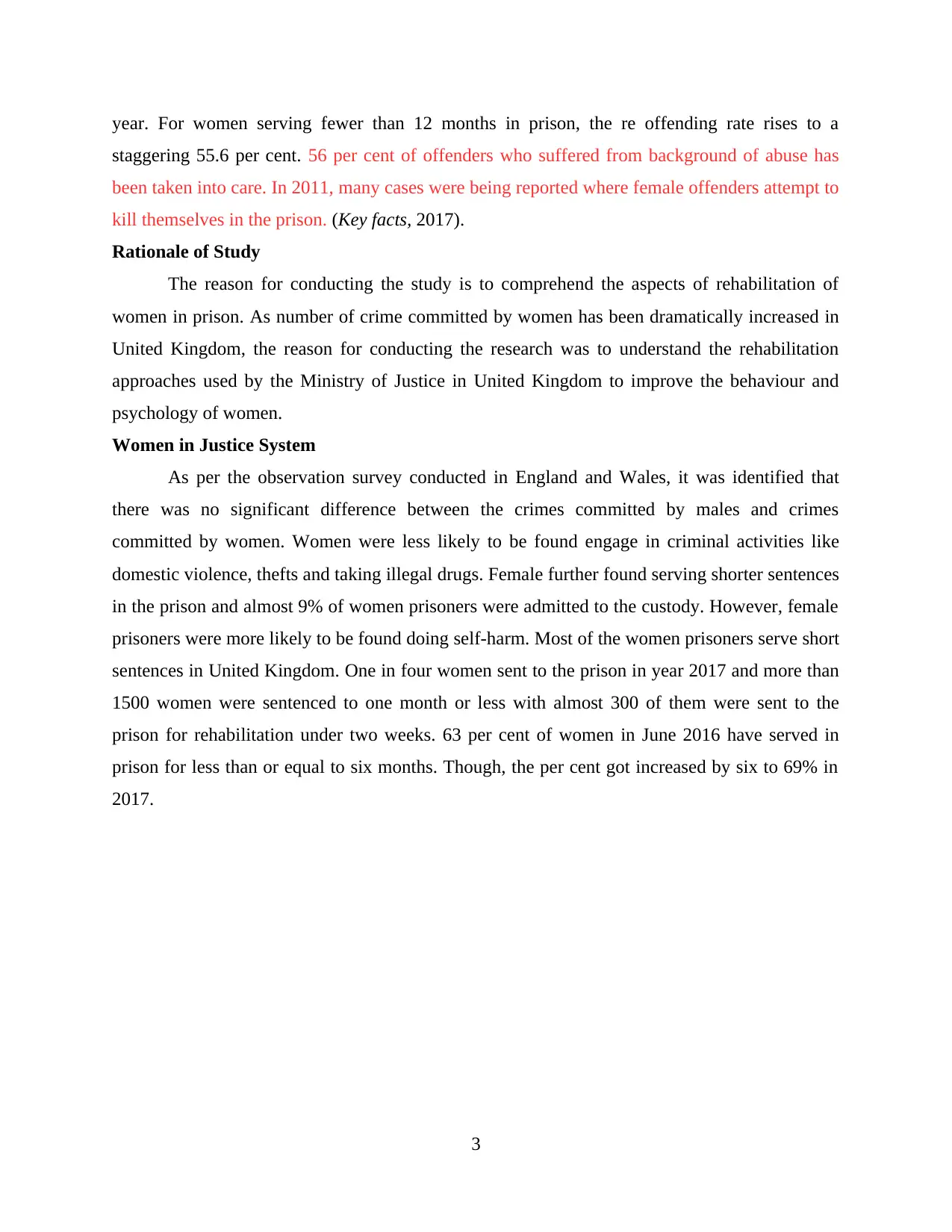
year. For women serving fewer than 12 months in prison, the re offending rate rises to a
staggering 55.6 per cent. 56 per cent of offenders who suffered from background of abuse has
been taken into care. In 2011, many cases were being reported where female offenders attempt to
kill themselves in the prison. (Key facts, 2017).
Rationale of Study
The reason for conducting the study is to comprehend the aspects of rehabilitation of
women in prison. As number of crime committed by women has been dramatically increased in
United Kingdom, the reason for conducting the research was to understand the rehabilitation
approaches used by the Ministry of Justice in United Kingdom to improve the behaviour and
psychology of women.
Women in Justice System
As per the observation survey conducted in England and Wales, it was identified that
there was no significant difference between the crimes committed by males and crimes
committed by women. Women were less likely to be found engage in criminal activities like
domestic violence, thefts and taking illegal drugs. Female further found serving shorter sentences
in the prison and almost 9% of women prisoners were admitted to the custody. However, female
prisoners were more likely to be found doing self-harm. Most of the women prisoners serve short
sentences in United Kingdom. One in four women sent to the prison in year 2017 and more than
1500 women were sentenced to one month or less with almost 300 of them were sent to the
prison for rehabilitation under two weeks. 63 per cent of women in June 2016 have served in
prison for less than or equal to six months. Though, the per cent got increased by six to 69% in
2017.
3
staggering 55.6 per cent. 56 per cent of offenders who suffered from background of abuse has
been taken into care. In 2011, many cases were being reported where female offenders attempt to
kill themselves in the prison. (Key facts, 2017).
Rationale of Study
The reason for conducting the study is to comprehend the aspects of rehabilitation of
women in prison. As number of crime committed by women has been dramatically increased in
United Kingdom, the reason for conducting the research was to understand the rehabilitation
approaches used by the Ministry of Justice in United Kingdom to improve the behaviour and
psychology of women.
Women in Justice System
As per the observation survey conducted in England and Wales, it was identified that
there was no significant difference between the crimes committed by males and crimes
committed by women. Women were less likely to be found engage in criminal activities like
domestic violence, thefts and taking illegal drugs. Female further found serving shorter sentences
in the prison and almost 9% of women prisoners were admitted to the custody. However, female
prisoners were more likely to be found doing self-harm. Most of the women prisoners serve short
sentences in United Kingdom. One in four women sent to the prison in year 2017 and more than
1500 women were sentenced to one month or less with almost 300 of them were sent to the
prison for rehabilitation under two weeks. 63 per cent of women in June 2016 have served in
prison for less than or equal to six months. Though, the per cent got increased by six to 69% in
2017.
3
⊘ This is a preview!⊘
Do you want full access?
Subscribe today to unlock all pages.

Trusted by 1+ million students worldwide
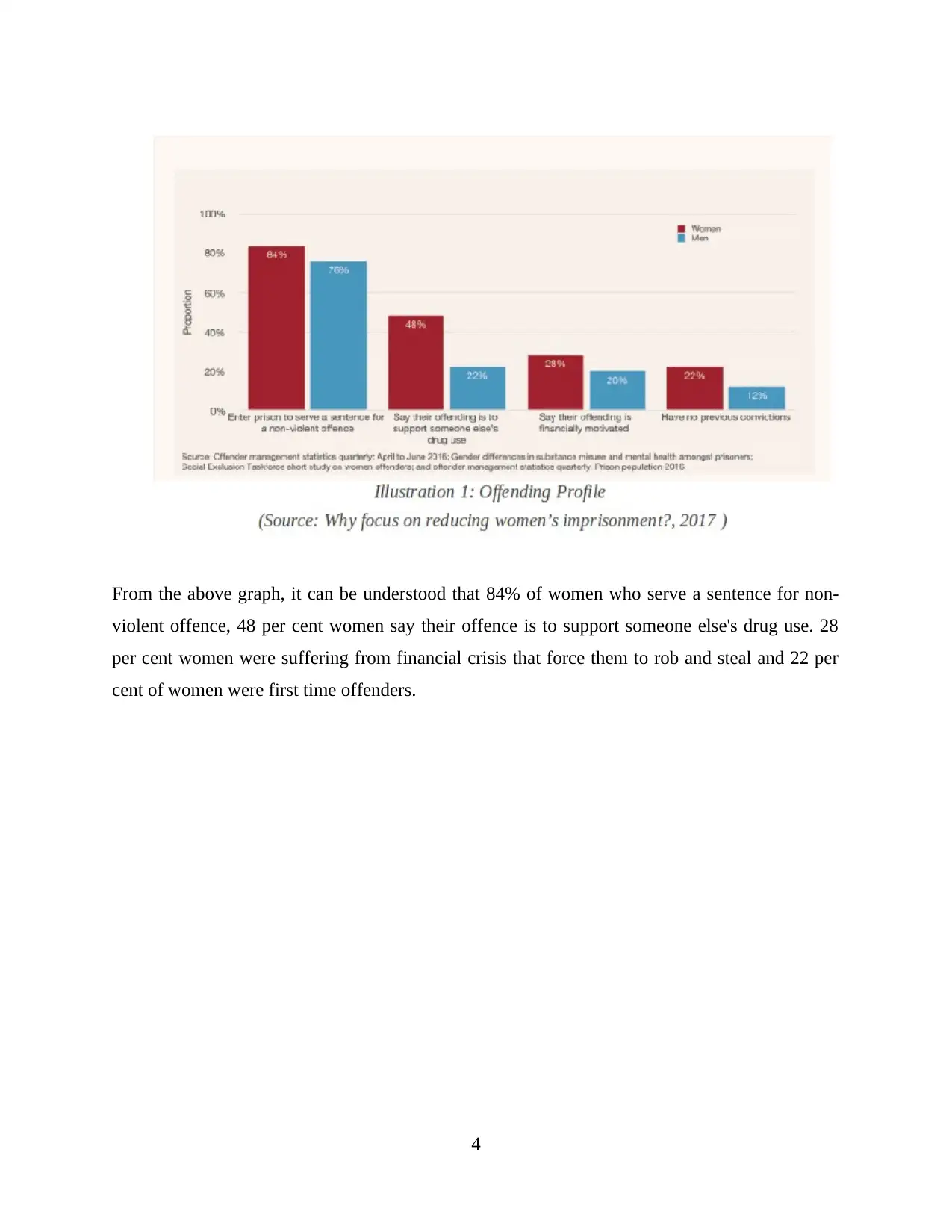
From the above graph, it can be understood that 84% of women who serve a sentence for non-
violent offence, 48 per cent women say their offence is to support someone else's drug use. 28
per cent women were suffering from financial crisis that force them to rob and steal and 22 per
cent of women were first time offenders.
4
violent offence, 48 per cent women say their offence is to support someone else's drug use. 28
per cent women were suffering from financial crisis that force them to rob and steal and 22 per
cent of women were first time offenders.
4
Paraphrase This Document
Need a fresh take? Get an instant paraphrase of this document with our AI Paraphraser
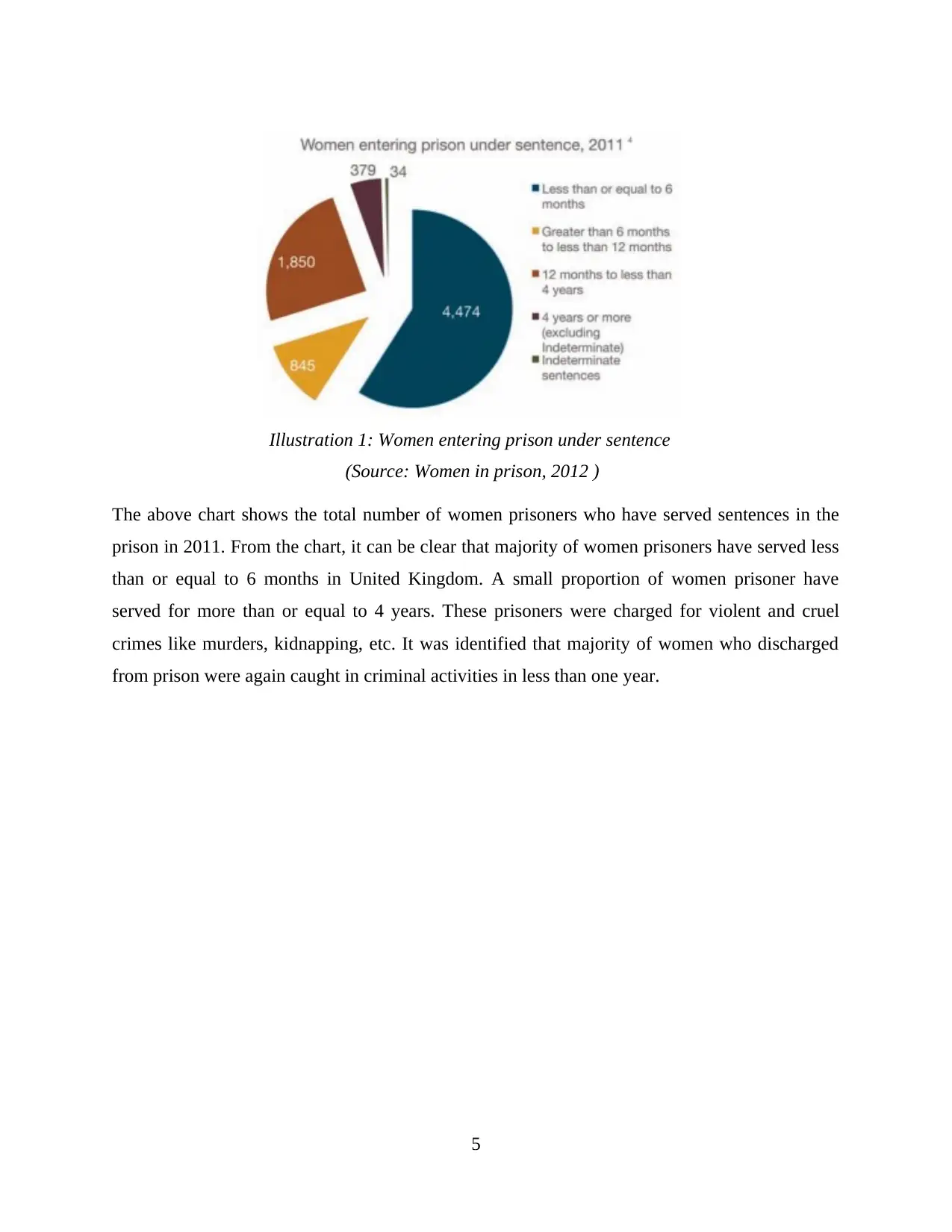
The above chart shows the total number of women prisoners who have served sentences in the
prison in 2011. From the chart, it can be clear that majority of women prisoners have served less
than or equal to 6 months in United Kingdom. A small proportion of women prisoner have
served for more than or equal to 4 years. These prisoners were charged for violent and cruel
crimes like murders, kidnapping, etc. It was identified that majority of women who discharged
from prison were again caught in criminal activities in less than one year.
5
Illustration 1: Women entering prison under sentence
(Source: Women in prison, 2012 )
prison in 2011. From the chart, it can be clear that majority of women prisoners have served less
than or equal to 6 months in United Kingdom. A small proportion of women prisoner have
served for more than or equal to 4 years. These prisoners were charged for violent and cruel
crimes like murders, kidnapping, etc. It was identified that majority of women who discharged
from prison were again caught in criminal activities in less than one year.
5
Illustration 1: Women entering prison under sentence
(Source: Women in prison, 2012 )
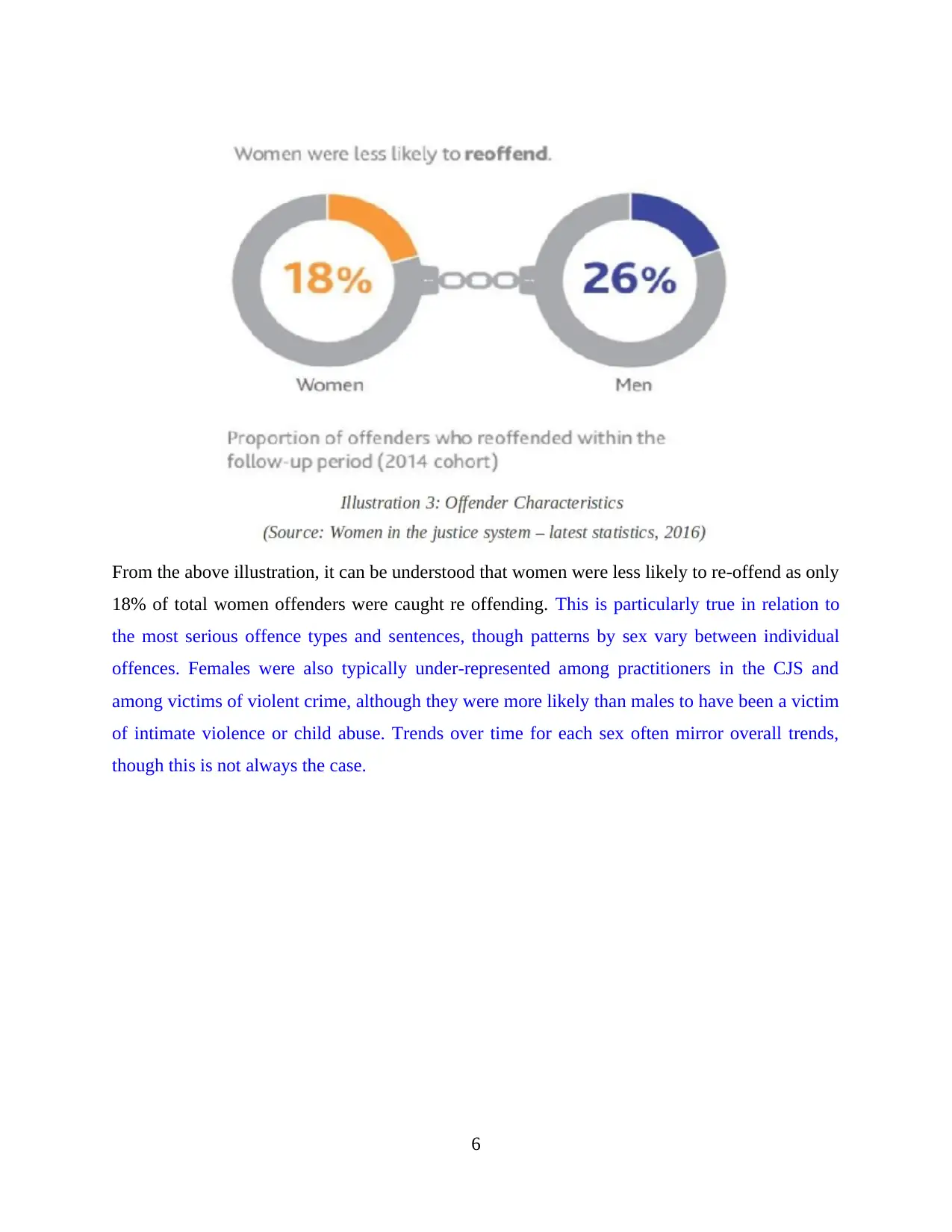
From the above illustration, it can be understood that women were less likely to re-offend as only
18% of total women offenders were caught re offending. This is particularly true in relation to
the most serious offence types and sentences, though patterns by sex vary between individual
offences. Females were also typically under-represented among practitioners in the CJS and
among victims of violent crime, although they were more likely than males to have been a victim
of intimate violence or child abuse. Trends over time for each sex often mirror overall trends,
though this is not always the case.
6
18% of total women offenders were caught re offending. This is particularly true in relation to
the most serious offence types and sentences, though patterns by sex vary between individual
offences. Females were also typically under-represented among practitioners in the CJS and
among victims of violent crime, although they were more likely than males to have been a victim
of intimate violence or child abuse. Trends over time for each sex often mirror overall trends,
though this is not always the case.
6
⊘ This is a preview!⊘
Do you want full access?
Subscribe today to unlock all pages.

Trusted by 1+ million students worldwide
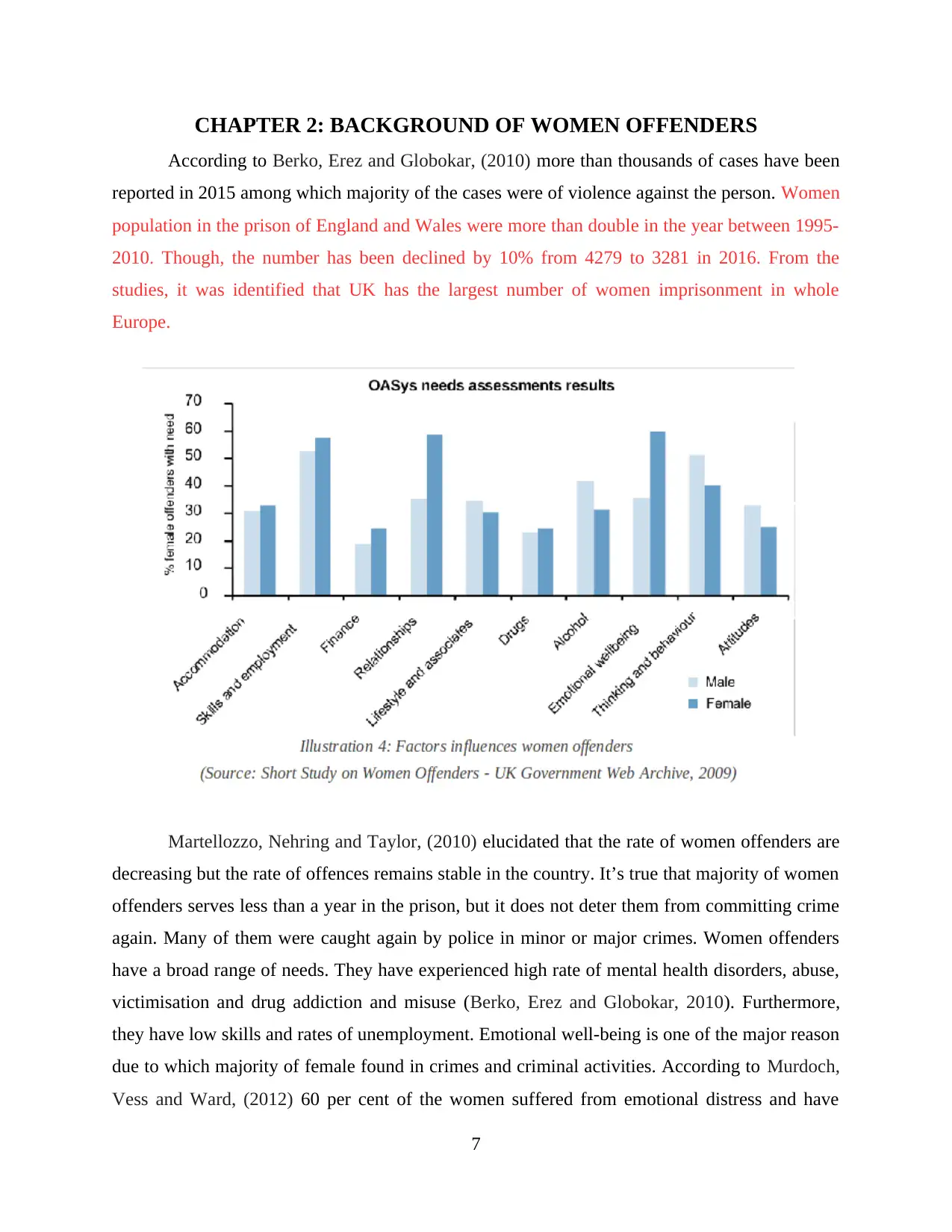
CHAPTER 2: BACKGROUND OF WOMEN OFFENDERS
According to Berko, Erez and Globokar, (2010) more than thousands of cases have been
reported in 2015 among which majority of the cases were of violence against the person. Women
population in the prison of England and Wales were more than double in the year between 1995-
2010. Though, the number has been declined by 10% from 4279 to 3281 in 2016. From the
studies, it was identified that UK has the largest number of women imprisonment in whole
Europe.
Martellozzo, Nehring and Taylor, (2010) elucidated that the rate of women offenders are
decreasing but the rate of offences remains stable in the country. It’s true that majority of women
offenders serves less than a year in the prison, but it does not deter them from committing crime
again. Many of them were caught again by police in minor or major crimes. Women offenders
have a broad range of needs. They have experienced high rate of mental health disorders, abuse,
victimisation and drug addiction and misuse (Berko, Erez and Globokar, 2010). Furthermore,
they have low skills and rates of unemployment. Emotional well-being is one of the major reason
due to which majority of female found in crimes and criminal activities. According to Murdoch,
Vess and Ward, (2012) 60 per cent of the women suffered from emotional distress and have
7
According to Berko, Erez and Globokar, (2010) more than thousands of cases have been
reported in 2015 among which majority of the cases were of violence against the person. Women
population in the prison of England and Wales were more than double in the year between 1995-
2010. Though, the number has been declined by 10% from 4279 to 3281 in 2016. From the
studies, it was identified that UK has the largest number of women imprisonment in whole
Europe.
Martellozzo, Nehring and Taylor, (2010) elucidated that the rate of women offenders are
decreasing but the rate of offences remains stable in the country. It’s true that majority of women
offenders serves less than a year in the prison, but it does not deter them from committing crime
again. Many of them were caught again by police in minor or major crimes. Women offenders
have a broad range of needs. They have experienced high rate of mental health disorders, abuse,
victimisation and drug addiction and misuse (Berko, Erez and Globokar, 2010). Furthermore,
they have low skills and rates of unemployment. Emotional well-being is one of the major reason
due to which majority of female found in crimes and criminal activities. According to Murdoch,
Vess and Ward, (2012) 60 per cent of the women suffered from emotional distress and have
7
Paraphrase This Document
Need a fresh take? Get an instant paraphrase of this document with our AI Paraphraser
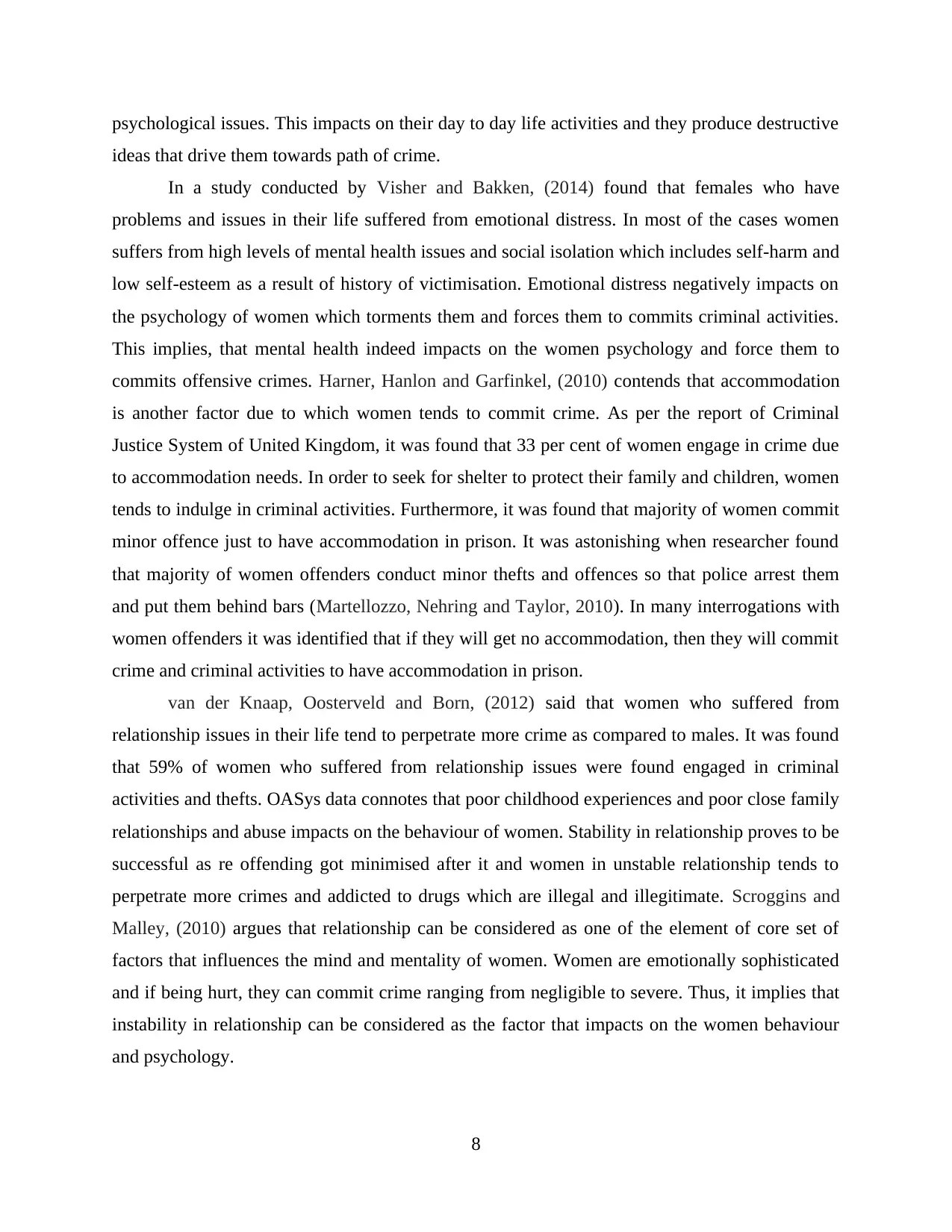
psychological issues. This impacts on their day to day life activities and they produce destructive
ideas that drive them towards path of crime.
In a study conducted by Visher and Bakken, (2014) found that females who have
problems and issues in their life suffered from emotional distress. In most of the cases women
suffers from high levels of mental health issues and social isolation which includes self-harm and
low self-esteem as a result of history of victimisation. Emotional distress negatively impacts on
the psychology of women which torments them and forces them to commits criminal activities.
This implies, that mental health indeed impacts on the women psychology and force them to
commits offensive crimes. Harner, Hanlon and Garfinkel, (2010) contends that accommodation
is another factor due to which women tends to commit crime. As per the report of Criminal
Justice System of United Kingdom, it was found that 33 per cent of women engage in crime due
to accommodation needs. In order to seek for shelter to protect their family and children, women
tends to indulge in criminal activities. Furthermore, it was found that majority of women commit
minor offence just to have accommodation in prison. It was astonishing when researcher found
that majority of women offenders conduct minor thefts and offences so that police arrest them
and put them behind bars (Martellozzo, Nehring and Taylor, 2010). In many interrogations with
women offenders it was identified that if they will get no accommodation, then they will commit
crime and criminal activities to have accommodation in prison.
van der Knaap, Oosterveld and Born, (2012) said that women who suffered from
relationship issues in their life tend to perpetrate more crime as compared to males. It was found
that 59% of women who suffered from relationship issues were found engaged in criminal
activities and thefts. OASys data connotes that poor childhood experiences and poor close family
relationships and abuse impacts on the behaviour of women. Stability in relationship proves to be
successful as re offending got minimised after it and women in unstable relationship tends to
perpetrate more crimes and addicted to drugs which are illegal and illegitimate. Scroggins and
Malley, (2010) argues that relationship can be considered as one of the element of core set of
factors that influences the mind and mentality of women. Women are emotionally sophisticated
and if being hurt, they can commit crime ranging from negligible to severe. Thus, it implies that
instability in relationship can be considered as the factor that impacts on the women behaviour
and psychology.
8
ideas that drive them towards path of crime.
In a study conducted by Visher and Bakken, (2014) found that females who have
problems and issues in their life suffered from emotional distress. In most of the cases women
suffers from high levels of mental health issues and social isolation which includes self-harm and
low self-esteem as a result of history of victimisation. Emotional distress negatively impacts on
the psychology of women which torments them and forces them to commits criminal activities.
This implies, that mental health indeed impacts on the women psychology and force them to
commits offensive crimes. Harner, Hanlon and Garfinkel, (2010) contends that accommodation
is another factor due to which women tends to commit crime. As per the report of Criminal
Justice System of United Kingdom, it was found that 33 per cent of women engage in crime due
to accommodation needs. In order to seek for shelter to protect their family and children, women
tends to indulge in criminal activities. Furthermore, it was found that majority of women commit
minor offence just to have accommodation in prison. It was astonishing when researcher found
that majority of women offenders conduct minor thefts and offences so that police arrest them
and put them behind bars (Martellozzo, Nehring and Taylor, 2010). In many interrogations with
women offenders it was identified that if they will get no accommodation, then they will commit
crime and criminal activities to have accommodation in prison.
van der Knaap, Oosterveld and Born, (2012) said that women who suffered from
relationship issues in their life tend to perpetrate more crime as compared to males. It was found
that 59% of women who suffered from relationship issues were found engaged in criminal
activities and thefts. OASys data connotes that poor childhood experiences and poor close family
relationships and abuse impacts on the behaviour of women. Stability in relationship proves to be
successful as re offending got minimised after it and women in unstable relationship tends to
perpetrate more crimes and addicted to drugs which are illegal and illegitimate. Scroggins and
Malley, (2010) argues that relationship can be considered as one of the element of core set of
factors that influences the mind and mentality of women. Women are emotionally sophisticated
and if being hurt, they can commit crime ranging from negligible to severe. Thus, it implies that
instability in relationship can be considered as the factor that impacts on the women behaviour
and psychology.
8
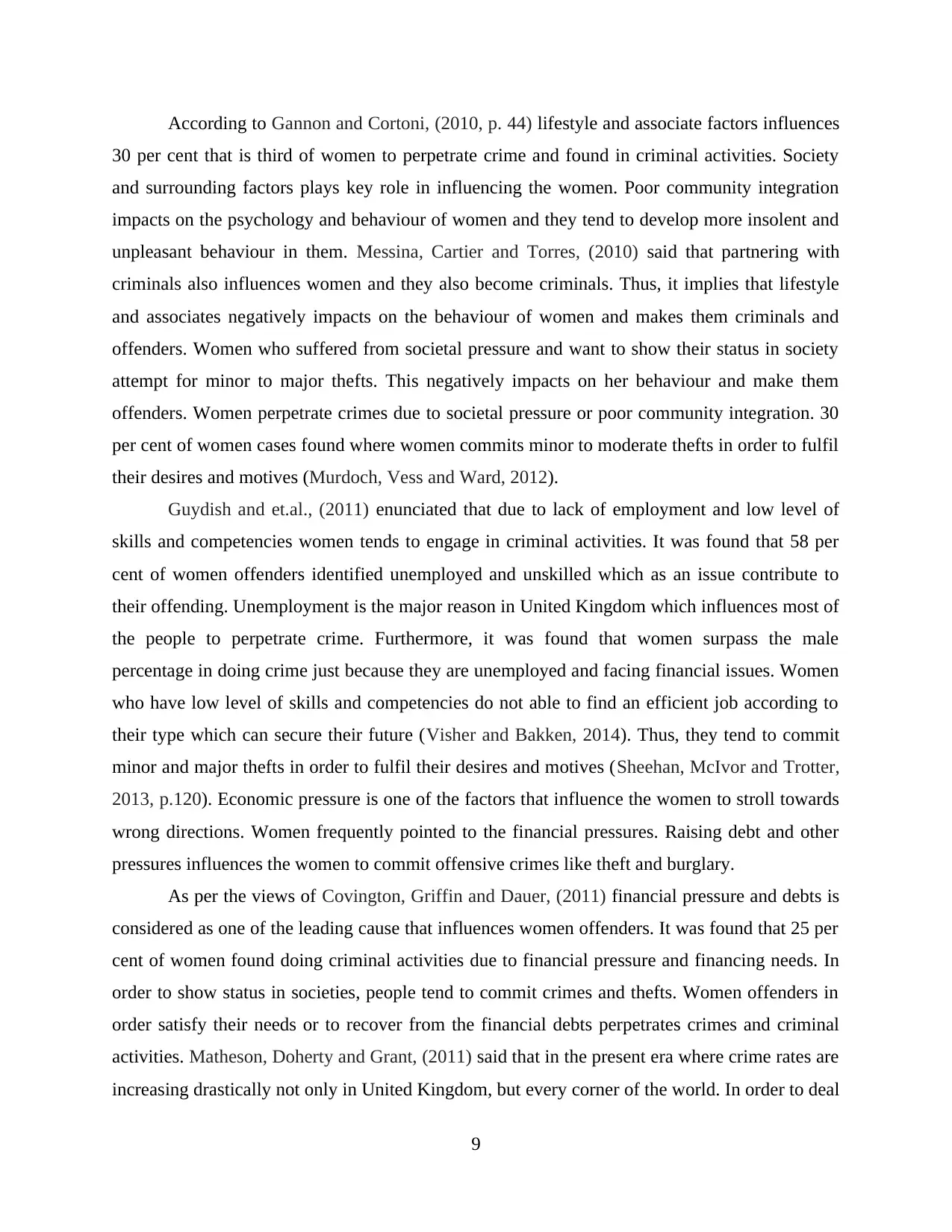
According to Gannon and Cortoni, (2010, p. 44) lifestyle and associate factors influences
30 per cent that is third of women to perpetrate crime and found in criminal activities. Society
and surrounding factors plays key role in influencing the women. Poor community integration
impacts on the psychology and behaviour of women and they tend to develop more insolent and
unpleasant behaviour in them. Messina, Cartier and Torres, (2010) said that partnering with
criminals also influences women and they also become criminals. Thus, it implies that lifestyle
and associates negatively impacts on the behaviour of women and makes them criminals and
offenders. Women who suffered from societal pressure and want to show their status in society
attempt for minor to major thefts. This negatively impacts on her behaviour and make them
offenders. Women perpetrate crimes due to societal pressure or poor community integration. 30
per cent of women cases found where women commits minor to moderate thefts in order to fulfil
their desires and motives (Murdoch, Vess and Ward, 2012).
Guydish and et.al., (2011) enunciated that due to lack of employment and low level of
skills and competencies women tends to engage in criminal activities. It was found that 58 per
cent of women offenders identified unemployed and unskilled which as an issue contribute to
their offending. Unemployment is the major reason in United Kingdom which influences most of
the people to perpetrate crime. Furthermore, it was found that women surpass the male
percentage in doing crime just because they are unemployed and facing financial issues. Women
who have low level of skills and competencies do not able to find an efficient job according to
their type which can secure their future (Visher and Bakken, 2014). Thus, they tend to commit
minor and major thefts in order to fulfil their desires and motives (Sheehan, McIvor and Trotter,
2013, p.120). Economic pressure is one of the factors that influence the women to stroll towards
wrong directions. Women frequently pointed to the financial pressures. Raising debt and other
pressures influences the women to commit offensive crimes like theft and burglary.
As per the views of Covington, Griffin and Dauer, (2011) financial pressure and debts is
considered as one of the leading cause that influences women offenders. It was found that 25 per
cent of women found doing criminal activities due to financial pressure and financing needs. In
order to show status in societies, people tend to commit crimes and thefts. Women offenders in
order satisfy their needs or to recover from the financial debts perpetrates crimes and criminal
activities. Matheson, Doherty and Grant, (2011) said that in the present era where crime rates are
increasing drastically not only in United Kingdom, but every corner of the world. In order to deal
9
30 per cent that is third of women to perpetrate crime and found in criminal activities. Society
and surrounding factors plays key role in influencing the women. Poor community integration
impacts on the psychology and behaviour of women and they tend to develop more insolent and
unpleasant behaviour in them. Messina, Cartier and Torres, (2010) said that partnering with
criminals also influences women and they also become criminals. Thus, it implies that lifestyle
and associates negatively impacts on the behaviour of women and makes them criminals and
offenders. Women who suffered from societal pressure and want to show their status in society
attempt for minor to major thefts. This negatively impacts on her behaviour and make them
offenders. Women perpetrate crimes due to societal pressure or poor community integration. 30
per cent of women cases found where women commits minor to moderate thefts in order to fulfil
their desires and motives (Murdoch, Vess and Ward, 2012).
Guydish and et.al., (2011) enunciated that due to lack of employment and low level of
skills and competencies women tends to engage in criminal activities. It was found that 58 per
cent of women offenders identified unemployed and unskilled which as an issue contribute to
their offending. Unemployment is the major reason in United Kingdom which influences most of
the people to perpetrate crime. Furthermore, it was found that women surpass the male
percentage in doing crime just because they are unemployed and facing financial issues. Women
who have low level of skills and competencies do not able to find an efficient job according to
their type which can secure their future (Visher and Bakken, 2014). Thus, they tend to commit
minor and major thefts in order to fulfil their desires and motives (Sheehan, McIvor and Trotter,
2013, p.120). Economic pressure is one of the factors that influence the women to stroll towards
wrong directions. Women frequently pointed to the financial pressures. Raising debt and other
pressures influences the women to commit offensive crimes like theft and burglary.
As per the views of Covington, Griffin and Dauer, (2011) financial pressure and debts is
considered as one of the leading cause that influences women offenders. It was found that 25 per
cent of women found doing criminal activities due to financial pressure and financing needs. In
order to show status in societies, people tend to commit crimes and thefts. Women offenders in
order satisfy their needs or to recover from the financial debts perpetrates crimes and criminal
activities. Matheson, Doherty and Grant, (2011) said that in the present era where crime rates are
increasing drastically not only in United Kingdom, but every corner of the world. In order to deal
9
⊘ This is a preview!⊘
Do you want full access?
Subscribe today to unlock all pages.

Trusted by 1+ million students worldwide
1 out of 32
Related Documents
Your All-in-One AI-Powered Toolkit for Academic Success.
+13062052269
info@desklib.com
Available 24*7 on WhatsApp / Email
![[object Object]](/_next/static/media/star-bottom.7253800d.svg)
Unlock your academic potential
Copyright © 2020–2025 A2Z Services. All Rights Reserved. Developed and managed by ZUCOL.





